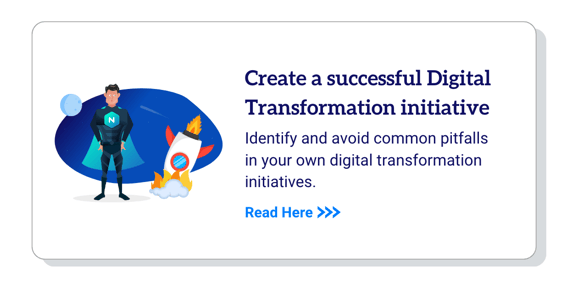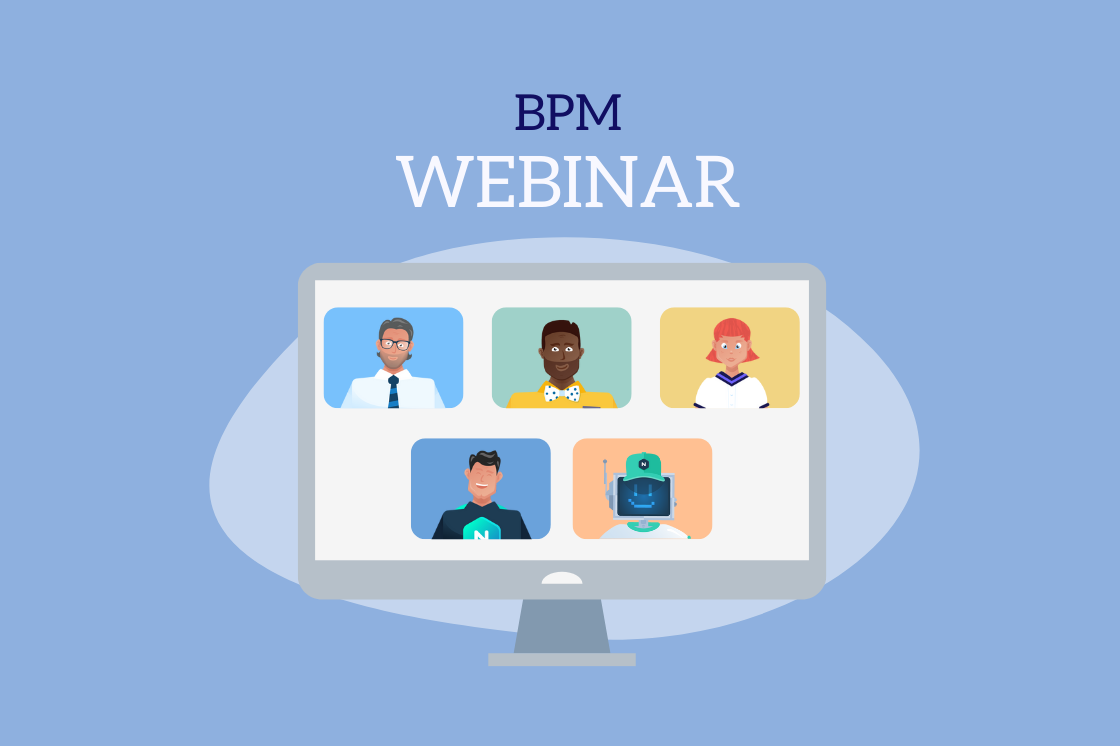Automation & Efficiency: Automate Business Processes to Drive Innovation
To remain competitive, organizations must continuously innovate. Business Process Automation (BPA) automates repetitive and costly tasks, freeing up time and resources for innovation and setting the stage for an improved customer experience.
Automation technology plays a crucial role in business processes by minimizing human intervention through tools like RPA for routine tasks. Additionally, AI and machine learning enhance automation technology, allowing systems to learn from data, make accurate predictions, and perform complex tasks. Business automation is a transformative force in enhancing efficiency and reducing costs.
We will look at how your organization can automate business processes, including:
- What is Business Process Automation?
- How to Automate Business Processes
- Identifying Candidates for Process Automation
- Business Process Automation Examples
- Business Process Automation Software
- The Benefits of Business Process Automation
- The Challenges of Business Process Automation
- Business Process Automation vs Business Process Management
What is Business Process Automation?
Business Process Automation (BPA) harnesses the power of technology to streamline and automate manual tasks, enabling organizations to optimize efficiency while simultaneously cutting costs.
Business Process Automation is a critical part of a Business Process Management program and works in conjunction with Process Discovery, Process Mapping, Process Execution, Process Governance, and Continual Process Improvement.
The primary goals of implementing business process automation (BPA) are to boost operational efficiency, drive cost savings, enhance precision and uniformity, foster collaboration, and streamline workflows.
Business Process Automation (BPA) can liberate employees, enabling them to concentrate on more advanced tasks that demand creativity and critical thinking, such as innovation and improving customer experience.
By streamlining processes, BPA can drive significant business growth, allowing teams to focus on strategic tasks that contribute to overall business expansion.
Automation is achieved through a range of cutting-edge platforms, such as robotics process automation (RPA), integrated workflow management solutions, and business intelligence (BI) software.
Business Process Automation enables digital transformation and Digital Enterprise initiatives.
How to Automate Business Processes
Industry analysts estimate up to 50% of process automation projects fail to deliver benefits. Don't become a statistic. Here is a business process automation methodology that will improve the success of your next BPA project.
- Identify processes that would benefit from automation. Look for quick wins, such as areas with many repetitive tasks.
- Conduct interviews and workshops with the key stakeholders to map their existing processes. Speak with as many people as possible, as the information may be scattered. Remember, you can't automate what you don't understand.
- Create an As-Is process map and analyze it to find trends or opportunities for improvement. Automating a flawed process will create more significant problems down the road. Learn more about process mapping and how it assists in automation..
- Keep the automation platform (or your implementation partners) from driving the project. Always start with the business process.
- Implementing robotic process automation (RPA) is crucial to reduce human errors and save time and costs, particularly in finance departments, where it can save thousands of hours in rework.
- Employ Organizational Change Management (OCM) practices to facilitate the roll out of new processes and technology
- Once automated organizations should employ Business Process Management (BPM) practices. The practices will ensure the processes are well-governed, efficient, and adaptable to changing conditions.
Organizations that optimize their business processes by employing these strategies can improve productivity and reduce costs.
Identifying candidates for process automation.
Identifying a particular business process to automate starts with a keen understanding of your current business processes and systems.
Identifying suitable candidates for a business process automation solution will be easy if your company has a robust and adequately staffed Business Process Management program. That's part of their job!
If that is not the case, you must start by meeting with teams across the organization. You must identify where team members spend substantial time on low-value, repetitive processes.
You can do this through a series of workshops and brainstorming sessions. It's essential to have some key team members, not only managers, attend these sessions. These team members will have a much deeper understanding of the processes and potential areas for improvement.
Analyzing customer data using AI and machine learning can help identify trends and personalize experiences, thereby improving operational efficiency. By leveraging customer data, businesses can forecast outcomes and enhance customer experiences, contributing to better overall performance.
Use the information collected to identify a short list of processes that could benefit from automation.
Learn more about process discovery and identification and how it can help you select the right candidates for automation.
Business Process Automation Examples
Business process automation through application software can drastically improve operational efficiency and reduce costs by automating repetitive tasks. Let's take a look at some of the problems business process automation can solve:
- Robotic Process Automation (RPA): Robotic Process Automation (RPA) is an automated system using software agents. It can perform repetitive, manual tasks such as data entry or updating customer records. One example of RPA is the approval of a credit card based on information provided by an applicant.
- Workflow Automation: Workflow automation is one of the most common forms of process automation. A typical example is an employee onboarding request. The automation platform coordinates requests across departments such as facilities management, information technology, payroll, benefits administration, and human resources. It then tracks the request through to completion.
- Document Generation: Document generation uses software to generate documents automatically, such as policies and contracts, based on user input. Many sales departments use process automation to create quotes. They also use it to generate contracts, route contracts for signature, create purchase orders, and then file the signed agreements.
- Customer Support: Chatbots are a type of process automation. They leverage artificial intelligence and natural language processing technologies to automate customer service and support. Chatbots offer an engaging and efficient way for customers to access information or assistance. Automating basic tasks frees up resources to focus on more complex customer issues.
- ITSM and Network management. Process automation is not only limited to business processes. Various ITSM (IT Service Management) workflows, such as provisioning, can benefit from process automation to improve efficiency and reduce errors.
- Digital Transformation: Digital transformation is leveraging digital technologies to create new business models, methods, products, services, and experiences for customers and employees. Check out the The Three Elements to a Successful Digital Transformation.
Business Process Automation Technologies
Automation technologies are the backbone of business process automation, enabling organizations to streamline and optimize their workflows. These technologies are designed to handle a variety of tasks, from simple repetitive actions to complex decision-making processes.
Here are some of the key automation technologies that are transforming business operations:
- Robotic Process Automation (RPA): RPA uses software robots to automate repetitive and rule-based tasks, such as data entry and invoice processing. By deploying RPA, businesses can free up human resources for more strategic activities, reducing the risk of human error and increasing operational efficiency.
- Business Process Automation (BPA) Software: BPA software provides a centralized platform for managing and automating business processes. It integrates various workflow management tools, task automation features, and data analysis capabilities, allowing organizations to streamline their operations and improve overall efficiency.
- Intelligent Automation Platforms. These are typically software suites that are the central hub for a company's automation efforts. They contain RPB, AI, and machine learning elements and can support very high volumes of transactions.
- Artificial Intelligence (AI) and Machine Learning (ML): AI and ML technologies enable organizations to automate complex tasks that require cognitive abilities, such as predictive analytics and customer sentiment analysis. These technologies help businesses make data-driven decisions, enhance operational efficiency, and deliver personalized customer experiences.
- Workflow Management Software. These are the more traditional automation platforms typically intended to automate mission critical processes in a specific business domain. Examples include IT Service Management process automation platforms, Marketing Automation Platforms, or Sales Force automation platforms.
- Business Intelligence (BI) Software. Business intelligence (BI) software is intricately linked to process automation, as it provides the data-driven foundation for identifying, optimizing, and implementing automated solutions within business processes.
- Business Process Modeling Tools: While not specifically an automation platform, business process modeling tools are crucial for any organization that wants to achieve success with Business Process Automation. They help in visualizing, analyzing, and designing business processes, providing a clear understanding of how things work before automating them. Check out our guide to selecting a business process modeling tools.
By leveraging these automation technologies, businesses can optimize their processes, reduce costs, and drive innovation.
But remember, these tools are not a "silver bullet." You still need to identify and map the processes you wish to automate. You also need to monitor the process, ensuring they continue to deliver value. The more power the platform you adopt, the more critical it is that you have a robust Business Process Management program.
The Benefits of Business Process Automation
Why automate business processes? The benefits of Business Process Automation include the following:
- Increased efficiency and accuracy: Automating repetitive, rules-based tasks eliminates manual errors and increases speed and accuracy.
- Improved customer experience: Automation allows organizations to provide better service by giving customers faster access to resources or answers to their queries.
- Access to data insights: Automation gives organizations real-time data to make informed decisions.
- More time for innovation: Automating tasks frees up resources for more innovative projects. These projects could be improving the customer experience or driving more revenue.
- Reduced costs: How does business process automation reduce costs? It is actually a combination of all of the above points. Less waste due to errors, improved customer retention, and improved data to improve efficiency and innovation. Combine this with reduced labor costs through automated processes, and BPA provides a tremendous opportunity for savings.
Check out this related article on the Benefits of Business Process Management.
The Challenges of Business Process Automation
Implementing BPA can present a variety of challenges, including:
- Limited knowledge of automation capabilities
- Difficulties in integrating disparate systems and applications into a cohesive view
- The lack of comprehensive data to enable accurate analyses.
One of the most prevalent hurdles when automating business processes is gaining a clear understanding of the end-to-end process.
This obstacle is particularly pronounced in large organizations where different departments hold different pieces of the process, and crucial information may reside solely in the minds of various stakeholders.
Consequently, investing time in mapping the existing process is essential before embarking on automation. Check out our guide to selecting a business process mapping tool.
Implementing automation solutions in an organization does come with some costs. These costs encompass the investment in technology, expenses related to implementation, and the potential need to hire or train business process automation staff. However, the gains in productivity that can be achieved through automation will ultimately outweigh these costs.
Furthermore, it is crucial to consider the ethical implications of replacing jobs with automated processes. Organizations must assume responsibility for assessing the impact on their staff and proceed in an ethical manner, prioritizing the well-being and livelihoods of their employees.
Measuring the Impact of Automation
Measuring the impact of automation is crucial for understanding its effectiveness and identifying areas for improvement. Here are some key metrics to consider:
- Productivity: One of the primary benefits of automation is the significant boost in productivity. By automating routine tasks, employees can focus on higher-value activities, leading to increased output and efficiency.
- Operational Efficiency: Automation streamlines workflows, reduces errors, and increases accuracy, all of which contribute to improved operational efficiency. Tracking metrics such as process cycle time and error rates can help organizations gauge the efficiency gains from automation.
- Cost Savings: Automation can lead to substantial cost savings by minimizing manual labor, reducing errors, and optimizing resource allocation. Monitoring cost-related metrics, such as labor costs and error-related expenses, can provide insights into the financial benefits of automation.
- Customer Satisfaction: Automation can enhance customer satisfaction by providing faster and more accurate services. Metrics such as response times, resolution times, and customer feedback scores can help organizations assess the impact of automation on customer experience.
By regularly measuring these metrics, organizations can ensure that their automation initiatives are delivering the desired outcomes and continuously improve their processes.
The Future of Business Process Automation
The future of business process automation is both exciting and rapidly evolving. Here are some key trends and predictions that are shaping the future of this field:
- Increased Adoption of AI and ML: AI and ML technologies will continue to play a major role in business process automation. These technologies enable organizations to automate complex tasks, make data-driven decisions, and improve operational efficiency. As AI and ML become more advanced, their applications in business process automation will expand, driving further innovation.
- Growing Demand for RPA: The demand for Robotic Process Automation (RPA) is expected to grow as more organizations recognize its potential to automate repetitive and rule-based tasks. RPA will continue to be a key tool for businesses looking to improve efficiency and reduce costs.
- Integration with Emerging Technologies: Business process automation will increasingly integrate with emerging technologies such as blockchain, the Internet of Things (IoT), and cloud computing. These integrations will provide new opportunities for innovation, enabling organizations to create more efficient and secure processes.
- Focus on Customer Experience: As competition intensifies, businesses will place a greater emphasis on improving customer experience through automation. By providing faster and more accurate services, organizations can enhance customer satisfaction and loyalty.
Business Process Automation Vs. Business Process Management.
People often interchange the terms Business Process Automation (BPA) and Business Process Management (BPM).
Ideally, BPA is an outcome of a robust BPM program. In fact, a robust BPM program is essential for a successful Digital Transformation initiative.
BPA uses technology to automate routine business processes and standard operating procedures. The focus is on automating existing business processes and making them more efficient using robotics process automation (RPA) or workflow automation technologies.
On the other hand, Business Process Management (BPM) is a holistic approach to managing all aspects of a company's processes. It optimizes operations by identifying waste, streamlining business processes, collaborating between departments, and implementing controls to ensure accuracy and quality.
The main activities of BPM include:
- Process Discovery: This is the first step in your business process management (BPM) initiative. The goal is to fully understand the in-scope processes. This includes identifying what tasks are being performed, who is responsible for each task, and how these tasks are being carried out. Understanding how things are done today helps identify gaps and make improvements. Discovery can be done through interviews, workshops and by using automated business process capture, process discovery and process intelligence software. Learn more about process discovery.
- Process Mapping: Once you've discovered your processes, it is essential to document them clearly and consistently. This involves making visual representations of your processes through flowcharting, swim lanes or other business process mapping techniques. It is also important to capture goals, objectives, roles and responsibilities, metrics, policies and governance. Check out this introduction to process mapping article for some ideas to get you started.
- Process Automation: This involves automating a set of activities or business rules in BPM or workflow management software. The key to successful business process automation is well-defined processes and precise requirements.
- Process Execution: Ensuring your processes deliver value is an important management activity for today's digital businesses. Management requires that process metrics and controls defined as part of process modeling are measured and managed. This responsibility falls upon the process owner and the process manager.
- Process Governance: The activity of aligning business processes with organizational goals and regulatory requirements through establishment and enforcement of policies, procedures, and controls.
- Process Optimization and Improvement: Service improvement is at the core of companies' transformational journeys. You should review every process regularly with an eye on improving efficiency, reducing cost, and reducing waste.
Organizations that practice BPM will be more successful at automating their business processes. These organizations have a much better understanding of their current business processes and opportunities for improvement. Learn more about the benefits of Business Process Management.
They also tend to have a more structured approach towards automation, improving their chances of success.
Remember, Process Automation is a subset of an overall Business Process Management program.
Leverage Business Process Automation to improve efficiency, optimize workflows, reduce costs, and free up your team's time and energy to innovate and enhance customer experience.
Conclusion
In conclusion, business process automation is a critical component of modern business operations. It enables organizations to streamline and optimize their workflows, improve operational efficiency, and reduce costs.
By leveraging automation technologies such as RPA, BPA software, AI, and ML, businesses can automate repetitive and complex tasks, make data-driven decisions, and enhance customer satisfaction.
As the future of business process automation continues to evolve, it is essential for organizations to stay ahead of the curve, embracing emerging technologies and trends to drive innovation and growth.
Leverage Business Process Automation to improve efficiency, optimize workflows, reduce costs, and free up your team's time and energy to innovate and enhance customer experience.



